The Ground Observer Corps
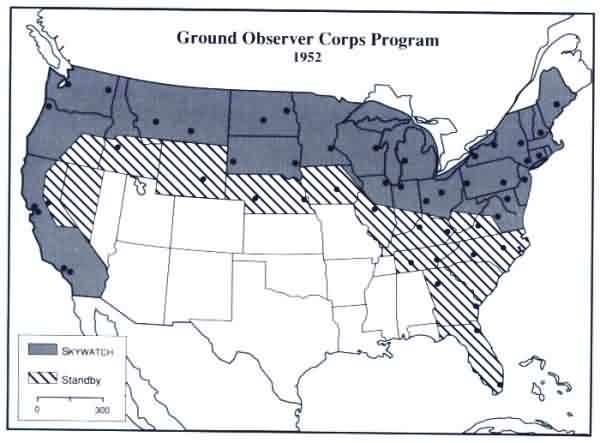
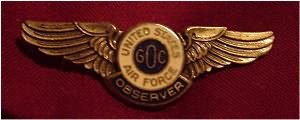 |
|
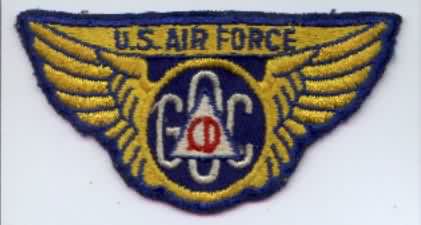
Patch shown approx. actual size
|
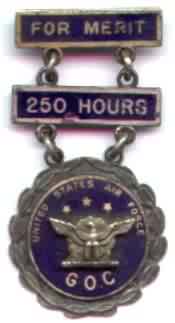
Pin shown approx. double actual size
|
|
Patch and pin above contributed by Joseph Zangri
|
|
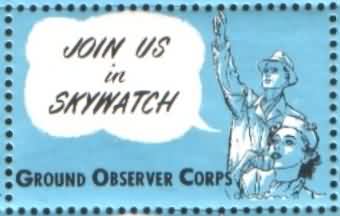
|
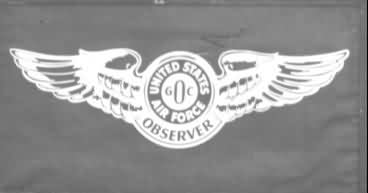
From a GOC banner
|
|
Skywatch sticker and wings above are circa 1957 and contributed by Bob Spiers, from the NEADS history program
|
|

|
|
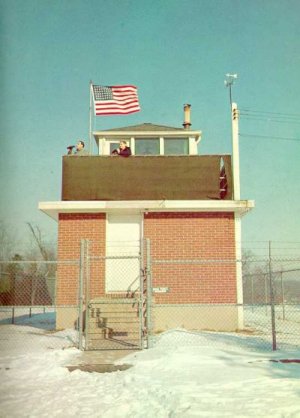
The Ground Observer Corps (GOC) traced its roots to World War II when 1.5 million civilian volunteers were enrolled by the Army Air Forces to man 14,000 observation posts positioned along the nation`s coasts. With limited radar detection capability, the GOC`s mission was to visually search the skies for enemy aircraft attempting to penetrate American airspace. With the declining threat to America from German and Japanese air forces, the Army Air Forces disestablished the GOC in 1944.
In February 1950, Continental Air Command Commander General Ennis C. Whitehead proposed the formation of a 160,000 civilian volunteer GOC to operate 8,000 observation posts scattered in gaps between the proposed radar network sites. With the belief that the Korean War served as a precursor to a possible Soviet attack, ADC had little difficulty recruiting volunteers. In 1951, some 210,000 GOC volunteers manning 8,000 observation posts and twenty-six filter centers were tested for the first time in nationwide exercises. The time recorded for a sighting report to reach the Ground Control Interception centers through the filter centers in this and subsequent drills was unimpressive. Subsequently, the scope of Whitehead`s plan was expanded to recruit more volunteers to man more observation posts on a continuing basis. This revised GOC plan, dubbed "Operation SKYWATCH," was initiated on July 14, 1952. Eventually over 800,000 volunteers stood alternating shifts at 16,000 observation posts and seventy-three filter centers. The Air Force used a variety of means to recruit volunteers, including radio. One radio spot announced:
"It may not be a very cheerful thought but the Reds right now have about a thousand bombers that are quite capable of destroying at least 89 American cities in one raid.... Won`t you help protect your country, your town, your children? Call your local Civil Defense office and join the Ground Observer Corps today."
Source: Schaffel, Emerging Shield, pp. 158 - 159.
By the late 1950s, deployment of the short-range AN/FPS-14 radar resolved the problem of detecting low-flying planes. Dozens of AN/FPS-14s and the follow-on model AN/FPS-18s were deployed at sites between the long range permanent and mobile radar statsions. As a result of this technological improvement, the ADC disestablished the Ground Observer Corps on January 31, 1959.
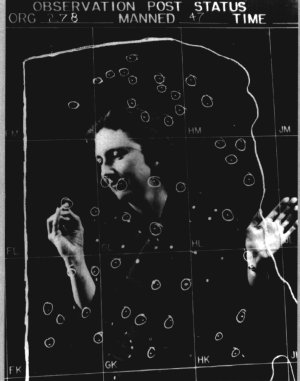
This photograph, taken in 1956, shows a Ground Observer Corps volunteer on duty in one of the seventy-three Continental Air Defense Command Filter Centers plotting the track of an aircraft using reports transmitted to her by other volunteers manning observer posts within the area. When the track was established, the information was forwarded to the Air Defense Direction Center, where the decision to scramble interceptor aircraft for identification purposes was made.
(Official U.S. Air Force photograph courtesy Air Force History Support Office.)
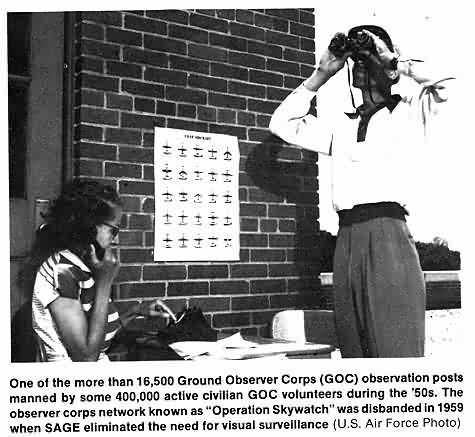
From the 25th Air Division "Skywatch", September 1977 (NORAD 20 Years Ago). contributed by Mike Rugg
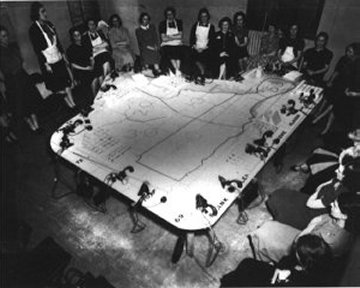
Reports from radars and Ground Observer Corps lookouts were fed into information centers. This photograph shows the filter board of the New York Information Center.
(Photo courtesy Air Force History Support Office)
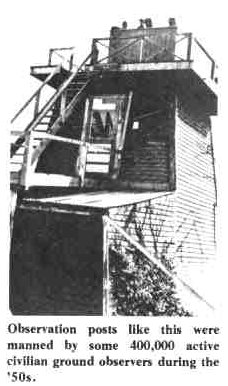
(Photo from September 1977 20th NORAD Region/Air Division "Rampart")
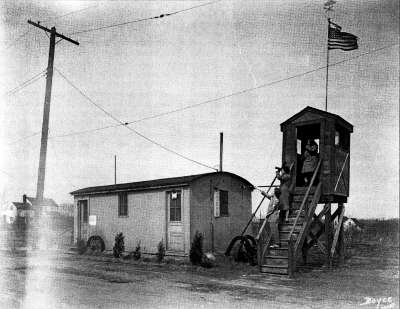
Contributed by Eleanor Brackbill
Elanor writes:
The caption says "Plane Spotters, Partridge Road, White Plains" and it comes from the Travis Collection of the Westchester County Historical Society in New York. It was published in an article, Arthur T. Broes, "White Plains Goes to War, 1941-1942," Westchester Historian, 72, no. 2 (Spring 1996), 39. The same article mentions that there was another plane spotter tower on Haviland's Lane, which is a couple of blocks away in a now fully-developed residential neighborhood of the small city of White Plains. The house on the far left in the picture is still there, but there are dozens of houses close by all around it today. These two streets are along a ridge and are a high point in the neighborhood.
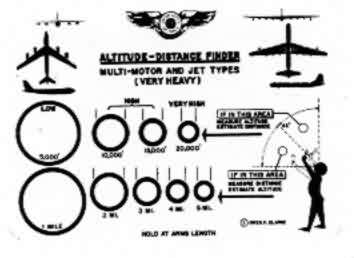
GOC volunteers used estimation templates such as this printed on transparent plastic sheet to gauge the altitude and distance of observed aircraft. This template is for multi-engined heavy bomber aircraft. The silhouettes appear to be a B-52 and a B-36.
World War II Ground Observer Corp - Aircraft Warning Service
Cairo IN Skywatch Tower, State Historical Site
A History of GOC Post 43-B, Swanville, ME
Post Delta Lima 3 - Green
Reno Filter Center Photos, mid-50s
Syracuse Filter Center
Operation Skywatch
From the 34th Air Division Yearbook, c. 1956. Part of a very large contribution by John Sheehan.
From the 25th Air Division Yearbook, ca. 1953-54, contributed by Roy Schotland
From the 26th Air Division Yearbook, c. 1956 contributed by Chuck Rowland
|
4670th GOS Filter-Center locations
(i.e., those that were operating in 1956).
The 1956 Yearbook for the 26th Air Division (Defense) actually lists street addresses for each Detachment (Filter Center), and "TerraServer" found every one of those addresses in its data base. I am not enclosing any down-loaded images or the "TerraServer" URLs, since you can easily obtain those yourselves using the addresses below.
Det. 1, 4670th GOS: 54 Wall Street, New Haven, CT
Det. 3, 4670th GOS: 200 State Street, Trenton, NJ
Det. 4, 4670th GOS: 100 North Cameron Street, Harrisburg, PA
Det. 10, 4670th GOS: 1257 Elm Street, Manchester, NH
Det. 11, 4670th GOS: 268 Central Avenue (Rte. 5), Albany, NY
For those of you who might be wondering why certain detachment numbers are omitted, see the first newsletter, below -- a brief history is provided.
4760th Newsletters
|
From the 27th Air Division Yearbook, c. 1954 contributed by John E. Pounds
Add'l 4771st info submitted by Candace L. Campbell, Historian Shakespeare Club of Pasadena:
I am the Historian for the Shakespeare Club of Pasadena and have been doing research on our Clubhouse. I have recently discovered a bit of our history that intersects with information on your website regarding the 27th Air Division’s 4771st Ground Observer Corps.
The commanding officer in charge was Joe Fry. The Center was originally located in a building on Colorado Blvd but the parking was insufficient so they moved to our house.
I can tell you where the Pasadena Air Defense Filter Center was located from 1954-1958 – it was located in the building our Clubhouse currently occupies: 171 S. Grand Avenue Pasadena, CA 91105

The Pasadena Filter Center as it appears today.
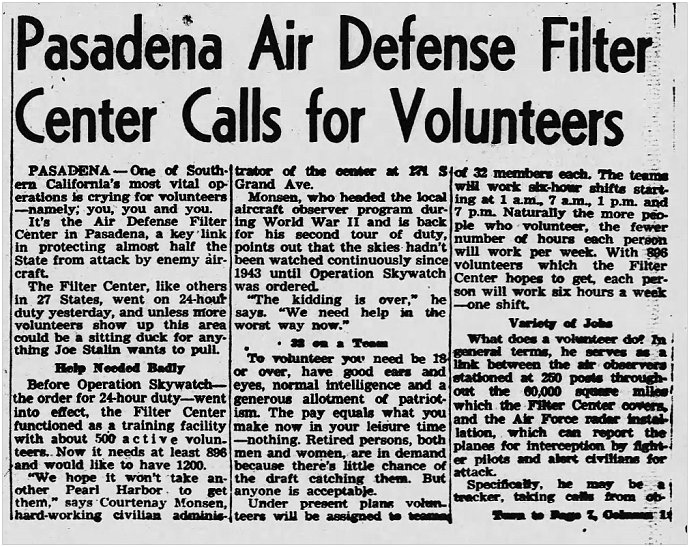
A call for volunteers for the Pasadena Filter Center.
From the 28th Air Division Yearbook, ca. 1954
From the 32nd Air Division Yearbook, ca. 1955
From the 58th Air Division Yearbook, c. 1957.
From the 85th Air Division Yearbook, c. 1957.
From the 20th Air Division (Defense) 1957 yearbook.
Newport, Maine Observer Post, contributed by Harold Nelson
Odebolt, Iowa GOC Post
Other Ground Observer Corps Links:















